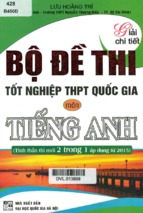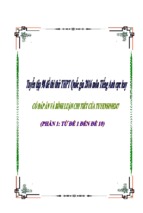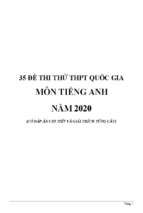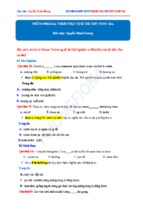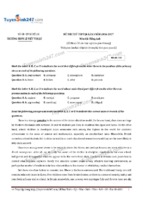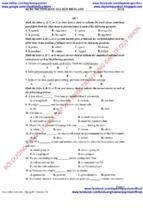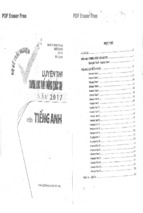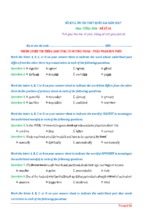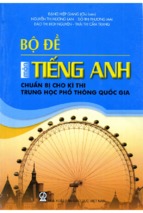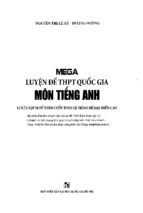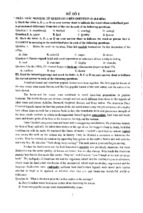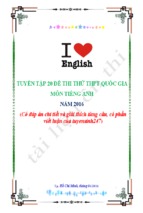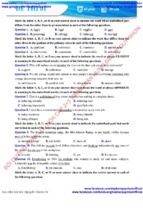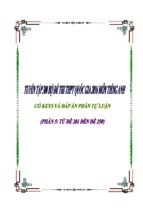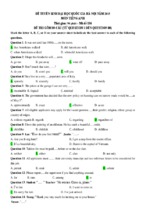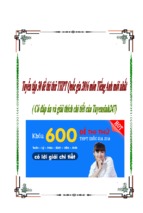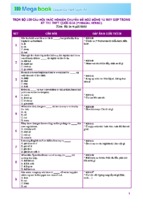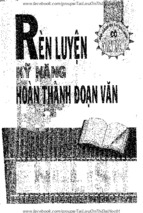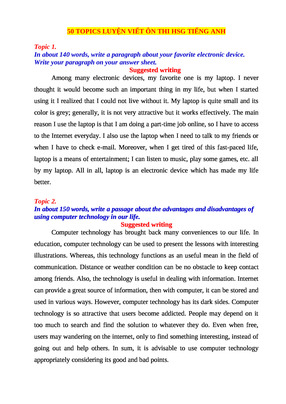BỘ GIÁO DỤC VÀ ĐÀO TẠO
ĐỀ CHÍNH THỨC
ĐỀ THI TUYỂN SINH ĐẠI HỌC NĂM 2011
Môn: TIẾNG ANH; Khối D
Thời gian làm bài: 90 phút, không kể thời gian phát đề
ĐỀ THI GỒM 80 CÂU (TỪ QUESTION 1 ĐẾN QUESTION 80)
I. Mark the letter A, B, C, or D on your answer sheet to indicate the correct answer
to each of the following questions.
Question 1: He never lets anything ______ him and his weekend fishing trip.
A. come up
B. come between
C. come among
D. come on
A. come up: tới gần, đến gần
B. come between: xen vào
C. come among:
D. come on: tiếp, đi tới
Dịch: "Anh ấy không bao giờ để bất cứ thứ gì xen vào giữa anh ấy và chuyến câu cá
cuối tuần của mình."
B là hợp nghĩa
Question 2: “You’ll recognize Jenny when you see her. She ______ a red hat.”
A. wears
B. will wear
C. is wearing
D. will be wearing
Dịch: “Bạn sẽ nhận ngay ra Jenny khi bạn gặp cô ấy. Cô ấy đội 1 chiếc mũ màu đỏ.”
Hành động “đội” xảy ra trong tương lai và “đang diễn ra” tại thời điểm “gặp” => dùng thì
tương lai tiếp diễn => chọn D
Question 3: Before I left for my summer camp, my mother told me to take warm clothes
with me ______ it was cold.
A. whereas
B. despite
C. in case
D. so that
A. whereas: Trong khi (ý đối lập)
B. despite: Mặc dù ( ý nhượng bộ)
C. in case: Nếu, phòng khi (điều kiện)
D. so that: Để (mục đích)
C là hợp nghĩa
Question 4: This shirt is ______ that one.
A. as much expensive as
B. a bit less expensive
C. much far expensive than
D. not nearly as expensive as
- Loại A vì không dùng “much” trong hình thức so sánh ngang bằng,
- Loại B vì thiếu “than” (less…than)
- Loại C vì không dùng đồng thời “much” và “far” để chỉ mức độ trong hình thức so
sánh.
=> chọn D
Question 5: The Second World War ______ in 1939.
A. took out
B. turned up
C. broke out
D. brought about
- take out: thủ tiêu, trả thù
- turn up: xuất hiện
- break out: bùng nổ
- bring about: gây ra, kéo theo
=> chọn C
Question 6: “Never be late for an interview, ______ you can’t get the job.”
A. otherwise
B. unless
C. or so
D. if not
A:otherwise( Nếu không thì).
- “Otherwise” là 1 liên từ thường được dùng trong câu điều kiện, sau “otherwise” là 1
mệnh đề chỉ kết quả. Khi đứng ở đầu câu nó được ngăn cách với mệnh đề bằng dấu “,”;
khi đứng trong câu nó được ngăn cách với mệnh đề điều kiện bởi dấu “,”
Eg: My parents lent me the money. Otherwise, I couldn't have afforded the trip.
Shut the window, otherwise it'll get too cold in here.
- “otherwise” cũng có thể được dùng như 1 trạng từ
Eg: You must be thankful to your parents’ care. You wouldn’t be able to survive
otherwise.
B.unless: trừ phi = if…not
- “unless” bắt đầu mệnh đề điều kiện trong câu điều kiện.
- mệnh đề sau “unless” phải là khẳng định.
“unless” không thể dùng trong câu này vì “you can’t get the job” là mệnh đề chỉ hệ quả
chứ không phải điều kiện. => loại B
C. or so:
Chúng ta có thể dùng “or” nhưng không dùng “or so” => loại C
D. if not: Nếu không
Trong câu này: if not = if you are late for an interview (if not tương đương với 1 mệnh
đề)
Tuy nhiên sau mệnh đề “if not” phải có dấu “,” => loại D
=> chọn A.
Question 7: The sky was cloudy and foggy. We went to the beach, ______.
A. however
B. so
C. even though
D. yet
“so”, “even though” và “yet” đều là các liên từ nên phải đứng đầu 1 mệnh đề. Chỉ có
“however” là trạng từ và có thể đứng độc lập.=> chọn A
Question 8: Sue: “Can you help me with my essay?”
Robert: “______”
A. Why not?
B. Not completely.
C. I think that, too.
D. Yes, I’m afraid not.
- A.Why not ?( Tại sao lại không?) => câu đáp lại ngầm ý chấp nhận lời đề nghị
- B.Not completely = partially, not fully => không hợp nghĩa
- C là 1 câu bày tỏ quan điểm hơn là câu trả lời cho 1 lời đề nghị. => loại
- Câu D, 2 vế trước và sau mâu thuẫn => loại
=> chọn A
Question 9: Harry: “Are you ready, Kate? There’s not much time left.”
Kate: “Yes, just a minute. ______!”
A. I’m coming
B. I won’t finish
C. I’d be OK
D. No longer
(Harry: "Sẵn sàng chưa, Kate? Không có nhiều thời gian còn lại đâu.”
Kate: "Ừ, một chút nữa thôi. Tớ ra ngay đây.")
Question 10: “Why don’t you sit down and ______?”
A. make yourself at home
B. make it your own home
C. make yourself at peace
D. make yourself at rest
Cụm "make yourself at home" (tự nhiên như ở nhà, không khách sáo) thường được
dùng để nói một người khách có thể cư xử bớt nghi thức hơn.
Question 11: The instructor blew his whistle and ______.
A. off the runners were running
B. the runners run off
C. off ran the runners
D. off were running the runners
- Câu này chỉ đơn giản là liệt kê 2 hành động trong quá khứ nên A và D bị loại ngay vì
dùng QKTD.
- B cũng bị loại vì dùng hiện tại đơn.
- Còn C. Đáp án C có hình thức khá lạ nhưng thực chất là 1 dạng đảo ngữ.
Trạng từ “off” được đảo lên trước kéo theo đảo cả động từ lên trước chủ ngữ.
Lưu ý: Hình thức đảo ngữ có thể được áp dụng với các động từ chuyển động đi kèm theo
là các trạng từ chỉ phương hướng như: away, up, down, out, in, off, over…
Nhưng nếu chủ ngữ là đại từ thì động từ phải theo sau chủ ngữ.
Question 12: The temperature ______ takes place varies widely from material to
material.
A. at which they melt
B. which melting
C. at which melting
D. which they melt
- Trong câu này có 2 động từ được chia đứng liền kề nhau => chỉ có 1 động từ chính và
động từ còn lại thuộc mệnh đề quan hệ.
- Động từ “varies” bổ nghĩa cho “The temperature” và động từ của mệnh đề quan hệ là
“takes place” chia ở số ít. => loại A và D vì thấy có “they” là chủ ngữ số nhiều.
- Xét B và C. Trong câu này chúng ta phải hiểu “melting” là 1 danh từ chứ không phải là
động từ dạng V-ing => xét đại từ quan hệ => dùng “at which” (= at the temperature)
=> chọn C
Dịch: “ Nhiệt độ tại đó hiện tượng tan chảy xảy ra rất khác nhau ở những chất khác
nhau.”
Question 13: “We'd better ______ if we want to get there in time.”
A. put down
B. speed up
C. take up
D. turn down
- put down: hạ cánh
- speed up: tăng tốc
- take up: tiếp tục
- turn sth/sb down: gạt bỏ, bác bỏ
Question 14: I could not ______ the lecture at all. It was too difficult for me.
A. get along
B. make off
C. hold on
D. take in
- get along: xoay sở
- make off: đi mất, chuồn
- hold on: chờ, ngừng
- take sth in/ take in sth: tiếp thu
Question 15: Alfonso: “I had a really good time. Thanks for the lovely evening.”
Maria: “______.”
A. No, it’s very kind of you
B. Oh, that’s right
C. I’m glad you enjoyed it
D. Yes, it’s really good
Để đáp lại lời khen “Thanks for the lovely evening.” (Cám ơn cậu vì buổi tối tuyệt vời.),
phải dùng “I’m glad you enjoyed it” (Mình vui vì cậu thích.)
Question 16: ______ without animals and plants?
A. How will life on earth be like
B. How would life on earth be for
C. What would life on earth be like
D. What will life on earth be like
- Loại A vì sai cấu trúc ngữ pháp ( không dùng “how” với “like” trong câu hỏi về tính
chất)
- Loại B vì sai cấu trúc ngữ pháp ( không dùng “how” với “for”. Chúng ta chỉ có cấu trúc:
“ What… for? – hỏi về mục đích.)
- C và D giống nhau chỉ khác mỗi cách dùng “would” và “will”. Đến đây chúng ta xét
nghĩa của câu : “Cuộc sống trên trái đất sẽ như thế nào nếu như không có cây cối và động
vật?”
Không có cây cối và động vật là điều không có thật ở hiện tại => câu này thực chất là câu
điều kiện loại 2 => chọn C
* chú ý: without animals and plants = if there were no animals and plants
Question 17: “You ______ have cooked so many dishes. There are only three of us for
lunch.”
A. couldn’t
B. wouldn’t
C. needn’t
D. oughtn’t
needn’t + have PII : không cần phải làm gì (mặc dù đã làm rồi)
Dịch: Đáng lẽ cậu không cần nấu nhiều món như thế. Chỉ có 3 chúng ta ăn trưa thôi mà
Question 18: The sign “NO TRESPASSING” tells you ______.
A. not to photograph
B. not to enter
C. not to smoke
D. not to approach
No trespassing! = Cấm vào!
Question 19: “______ you treat him, he’ll help you. He’s so tolerant.”
A. Even though
B. No matter how
C. As if
D. In addition to
Chúng ta có thể đoán được quan hệ giữa 2 vế của câu là quan hệ nhượng bộ.
- As if ( như thể là) -> thường dùng trong cấu trúc giả định.
- In addition to + N/ Ving: ngoài… -> dùng trong quan hệ bổ sung.
- Even though (mặc dù) -> dùng trong quan hệ nhượng bộ nhưng trong câu này nếu dùng
“even though” thì không đủ nghĩa.
- No matter how: dù cho… thế nào => chọn B
Dịch: “ Dù bạn đối xử với anh ấy thế nào, anh ấy vẫn sẽ giúp bạn. Anh ấy thật rộng
lượng.”
Ngoài “ how” chúng ta còn có thể dùng “no matter” với những từ để hỏi khác như “what,
where, when, which” với ý nghĩa gần tương tự.
no matter how = however
no matter what = whatever
no matter where = wherever
no matter when = whenever
no matter which = whichever
Question 20: I did not want to believe them, but in fact, ______ was true.
A. what they said
B. which they said
C. what has said
D. that they were said
what = the thing which
Question 21: Joan: “Our friends are coming. ______, Mike? ”
Mike: “I’m sorry, but I can’t do it now.”
A. Shall you make some coffee, please
B. Would you mind making some coffee
C. Why don’t we cook some coffee
D. Shall I make you like some coffee.
“shall” – dùng trong câu đề nghị làm việc gì cho ai.
“Why don’t we…” – dùng trong câu rủ rê ai làm gì.
“ Would you mind doing sth” – dùng trong câu đề nghị ai đó làm gì cho mình.
=> chọn B
Question 22: She built a high wall round her garden ______.
A. so that her fruit would be stolen
B. in order that her fruit not be stolen
C. to prevent her fruit from being stolen
D. to enable people not taking her fruit
Loại A vì không hợp nghĩa
Loại B vì sau “ in order that” phải là 1 mệnh đề trong đó động từ phải được chia theo thì.
Loại D vì sai cấu trúc. Cấu trúc đúng: (not) enable + O + to V
=>chọn C
prevent sb/sth from doing sth : ngăn ai/cái gì làm điều gì.
Question 23: The village was ______ visible through the dense fog.
A. only
B. barely
C. hard
D. mostly
barely = hardly, nearly : gần như không >< mostly : gần như
Question 24: If it ______ for the heavy storm, the accident would not have happened.
A. hadn’t been
B. weren’t
C. were
D. isn’t
For = because of
Câu điều kiện loại 3: S + had PII, S + would have PII
Question 25: Our boss would rather ______ during the working hours.
A. us not chatting
B. us not chat
C. we don’t chat
D. we didn’t chat
Các cấu trúc với “would rather”:
1. S + would rather + V/ notV => sự lựa chọn ở thời điểm hiện tại
2. S1 + would rather + S2 + Ved => lời yêu cầu trang trọng (mong muốn người khác
làm gì)
II. Mark the letter A, B, C, or D on your answer sheet to indicate the sentence that is
closest in meaning to each of the following questions.
Question 26: “You shouldn’t have leaked our confidential report to the press, Frank!”
said Jane.
A. Jane accused Frank of having cheated the press with their confidential
report.
B. Jane suspected that Frank had leaked their confidential report to the press.
C. Jane blamed Frank for having flattered the press with their confidential
report.
D. Jane criticized Frank for having disclosed their confidential report to the
press.
Cấu trúc: should (not) + have PII (đáng lẽ nên hoặc không nên làm gì) -> dùng để phàn
nàn về 1 việc đã xảy ra.
Dịch câu gốc: “Đáng lẽ anh không nên để lộ ra bản báo cáo mật của chúng ta cho giới
báo chí biết, Frank ạ!” Jane nói.
Đây là dạng bài tập chuyển câu trực tiếp sang câu gián tiếp sử dụng những cụm từ tường
thuật đặc biệt. Trong bài tập này chúng ta cần đặc biệt chú ý đến các động từ.
Accuse sb of doing sth: buộc tội, đổ lỗi
- Dịch nghĩa câu A: Jane buộc tội Frank đã lừa giới báo chí bằng bản báo cáo mật của họ.
=> Sai nghĩa => loại
Suspect that: cho rằng, nghi ngờ rằng
Dịch nghĩa câu B: Jane nghi ngờ rằng Frank đã làm rò rỉ bản báo cáo mật của họ cho giới
báo chí.
Theo như câu gốc thì Jane biết chắc chắn chứ không phải là nghi ngờ về hành động của
Frank => loại
Blame sb for doing sth: trách
Dịch nghĩa câu C: Jane trách Frank đã tâng bốc giới báo chí bằng bản báo cáo mật của
họ.
=> Sai nghĩa => loại
Criticize sb for doing sth: phê bình, chỉ trích
Dịch nghĩa câu D: Jane phê bình Frank vì đã để lộ bản báo cáo mật của họ cho giới báo
chí.
=> Gần nghĩa nhất với câu gốc => chọn D
Question 27: “Mum, please don’t tell dad about my mistake,” the boy said.
A. The boy begged his mother not to tell his father about his mistake.
B. The boy requested his mother not to talk about his mistake any more.
C. The boy earnestly insisted that his mother tell his father about his mistake.
D. The mother was forced to keep her son’s mistake as a secret when he
insisted.
Tương tự như câu trên, đây cũng là 1 câu yêu cầu chuyển câu trực tiếp sang gián tiếp.
Dịch câu gốc: “Mẹ, xin mẹ đừng nói cho biết lỗi của con,” cậu bé nói.
- beg sb (not) to do sth: nài nỉ
- Request sb (not) to do sth: yêu cầu
- earnestly insist that: tha thiết nài nỉ
- force sb (not) to do sth: bắt buộc
A. Cậu bé nài nỉ mẹ đừng nói cho bố cậu bế biết lỗi của cậu.
B. Cậu bé yêu cầu mẹ đừng nói về lỗi của cậu nữa.
C. Cậu bé tha thiết nài nỉ mẹ nói cho bố cậu biết về lỗi của cậu.
D. Bà mẹ bị buộc phải giữ bí mật về lỗi lầm của con trai mình khi cậu bé cố nài.
Căn cứ vào nghĩa của câu gốc thì chỉ có câu A là gần nghĩa nhất.
Question 28: “Don’t forget to tidy up the final draft before submission,” the team leader
told us.
A. The team leader simply wanted us to tidy up the final draft before
submission.
B. The team leader ordered us to tidy up the final draft before submission.
C. The team leader asked us to tidy up the final draft before submission.
D. The team leader reminded us to tidy up the final draft before submission.
Các đáp án giống nhau ở phần đầu và phần cuối chỉ khác nhau ở cách dùng động từ
tường thuật.
Nhìn vào câu gốc có từ “Don’t forget” chúng ta đoán đây là 1 lời nhắc nhở => chỉ có D là
hợp lí nhất => chọn D
Question 29: “If you don’t pay the ransom, we’ll kill your boy,” the kidnappers told us.
A. The kidnappers pledged to kill our boy if we did not pay the ransom.
B. The kidnappers threatened to kill our boy if we refused to pay the ransom.
C. The kidnappers promised to kill our boy if we refused to pay the ransom.
D. The kidnappers ordered to kill our boy if we did not pay the ransom.
Câu gốc:“ Nếu các vị không trả tiền chuộc, chúng tôi sẽ giết con trai các vị,” bọn bắt
cóc nói với chúng tôi.
- Pledge to do sth : cam kết, nguyện
- Threaten to do sth: đe dọa
- Promise to do sth: hứa
- Order sb to do sth: ra lệnh ( không có cấu trúc order to do sth)
Căn cứ vào nghĩa của nhừng cụm từ trên chọn B.
Question 30: “My company makes a large profit every year. Why don’t you invest more
money in it?” my friend said to me.
A. I was asked to invest more money in my friend’s company.
B. My friend persuaded me to invest more money in his company.
C. My friend instructed me how to put more money into his company.
D. My friend suggested his investing more money in his company.
Câu gốc: “Công ty mình thu được lợi nhuận lớn mỗi năm. Tại sao cậu không đầu tư thêm
tiền vào đó nhỉ?” bạn tôi nói với tôi.
Câu A => loại (Tôi được yêu cầu đầu tư thêm tiền vào công ty của bạn tôi.)
Câu B => ok (Bạn tôi thuyết phục tôi đầu tư thêm tiền vào công ty của anh ấy.)
Câu C => loại (Bạn tôi hướng dẫn tôi cách cho thêm tiền vào công ty anh ấy)
Câu D => loại vì sai cấu trúc Cấu trúc với " suggest":
1. S + suggest + Ving: gợi ý mình và ai cùng làm việc gì
2. S1 + suggest that + S2 + should + V: gợi ý ai làm việc gì
=> chọn B
III. Mark the letter A, B, C, or D on your answer sheet to indicate the word or
phrase that is closest in meaning to the underlined part in each of the following
questions.
Question 31: We have lived there for years and grown fond of the surroundings. That is
why we do not want to leave.
A. planted many trees in the surroundings
B. haunted by the surroundings
C. loved the surroundings
D. possessed by the surroundings
- Fond of: yêu thích
- Haunt: ám ảnh
- Possess: sở hữu
Lưu ý: Ta biết “fond” là 1 tính từ, vậy tại sao lại dùng tính từ bổ nghĩa cho động từ
“grown” ("have grown" nhưng được lược bỏ đi “have” do có ở trước đó rồi)?.
“grow” trong câu này không có nghĩa là “lớn lên” mà có nghĩa là “trở nên” và nó là
1 liking verb. Do đó sau “grow” ta dùng tính từ.
Question 32: His new work has enjoyed a very good review from critics and readers.
A. regard
B. opinion
C. viewing
D. look
review (n): sự phê bình, bài phê bình
1.
2.
3.
4.
regard (n) : sự quan tâm
opinion (n) : quan điểm, ý kiến
viewing (n): sự xem
look (n) : cái nhìn
Question 33: Such problems as haste and inexperience are a universal feature of youth.
A. separated
B. shared
C. hidden
D. marked
universal (adj): chung, mang tính toàn cầu
IV. Mark the letter A, B, C, or D on your answer sheet to indicate the word or
phrase that is OPPOSITE in meaning to the underlined part in each of the following
questions.
Question 34: There is growing concern about the way man has destroyed the
environment.
A. consideration
B. ease
C. speculation
D. attraction
concern (n): sự quan tâm, lo lắng
consideration (n): sự xem xét
ease (n): sự thanh thản, thoải mái
speculation (n): sự suy xét
attraction (n) : sự thu hút
Question 35: Fruit and vegetables grew in abundance on the island. The islanders even
exported the surplus.
A. excess
B. small quantity
C. large quantity
D. sufficiency
abundance (n) : sự phong phú, thừa thãi
excess (n) : sự quá mức, thừa mứa
small quantity : số lượng nhỏ
large quantity : số lượng lớn
sufficiency (n) : sự đầy đủ
V. Read the following passage adapted from A. Briggs’ article on culture,
Microsoft® Student 2008, and mark the letter A, B, C, or D on your answer sheet to
indicate the correct answer to each of the questions from 36 to 45.
Culture is a word in common use with complex meanings, and is derived, like the term
broadcasting, from the treatment and care of the soil and of what grows on it. It is directly
related to cultivation and the adjectives cultural and cultured are part of the same verbal
complex. A person of culture has identifiable attributes, among them a knowledge of and
interest in the arts, literature, and music. Yet the word culture does not refer solely to such
knowledge and interest nor, indeed, to education. At least from the 19th century onwards,
under the influence of anthropologists and sociologists, the word culture has come to be
used generally both in the singular and the plural (cultures) to refer to a whole way of life
of people, including their customs, laws, conventions, and values.
Distinctions have consequently been drawn between primitive and advanced culture and
cultures, between elite and popular culture, between popular and mass culture, and most
recently between national and global cultures. Distinctions have been drawn too between
culture and civilization; the latter is a word derived not, like culture or agriculture, from
the soil, but from the city. The two words are sometimes treated as synonymous. Yet this
is misleading. While civilization and barbarism are pitted against each other in what
seems to be a perpetual behavioural pattern, the use of the word culture has been strongly
influenced by conceptions of evolution in the 19th century and of development in the
20th century. Cultures evolve or develop. They are not static. They have twists and turns.
Styles change. So do fashions. There are cultural processes. What, for example, the word
cultured means has changed substantially since the study of classical (that is, Greek and
Roman) literature, philosophy, and history ceased in the 20th century to be central to
school and university education. No single alternative focus emerged, although with
computers has come electronic culture, affecting kinds of study, and most recently digital
culture. As cultures express themselves in new forms not everything gets better or more
civilized.
The multiplicity of meanings attached to the word made and will make it difficult to
define. There is no single, unproblematic definition, although many attempts have been
made to establish one. The only non-problematic definitions go back to agricultural
meaning (for example, cereal culture or strawberry culture) and medical meaning (for
example, bacterial culture or penicillin culture). Since in anthropology and sociology we
also acknowledge culture clashes, culture shock, and counter-culture, the range of
reference is extremely wide.
Question 36: According to the passage, the word culture ______.
A. is related to the preparation and use of land for farming
B. derives from the same root as civilization does
C. comes from a source that has not been identified
D. develops from Greek and Roman literature and history
Câu đầu đoạn 1 : “Culture is…from the treatment and care of the soil and of what grows
on it”
Question 37 : It is stated in paragraph 1 that a cultured person ______.
A. has a job related to cultivation
B. does a job relevant to education
C. takes care of the soil and what grows on it
D. has knowledge of arts, literature, and music
Dòng 3 + 4 đoạn 1: “A person of culture has identifiable attributes, among them a
knowledge of and interest in the arts, literature, and music.”
Question 38: The author remarks that culture and civilization are the two words that
______.
A. are both related to agriculture and cultivation
B. have nearly the same meaning
C. share the same word formation pattern
D. do not develop from the same meaning
Dòng 3 + 4 đoạn 2: “Distinctions have been drawn too between culture and civilization;
the latter is a word derived not, like culture or agriculture, from the soil, but from the
city.”
Question 39: It can be inferred from the passage that since the 20th century ______.
A. classical literature, philosophy, and history have not been taught as
compulsory subjects
B. all schools and universities have taught classical literature, philosophy, and
history
C. schools and universities have not taught classical literature, philosophy, and
history
D. classical literature, philosophy, and history have been considered as core
subjects
Dòng 10+11 đoạn 2: “…since the study of classical (that is, Greek and Roman) literature,
philosophy, and history ceased in the 20th century to be central to school and university
education.”
cease (v) = stop
Question 40: The word “attributes” in paragraph 1 most likely means ______.
A. aspects
B. fields
C. skills
D. qualities
attributes: đặc tính
A. aspects: diện mạo, khía cạnh,
B. fields: lĩnh vực,
C. skills: kỹ năng,
D. qualities: đặc tính, phẩm chất
Question 41: The word “static” in paragraph 2 could best be replaced by “______”.
A. unchanged
B. regular
C. balanced
D. dense
static (adj) : tĩnh
A. unchanged: Không thay đổi,
B. regular: đều đặn,
C. balanced: cân bằng,
D. dense: dày đặc
Question 42: Which of the following is NOT stated in the passage?
A. The use of the word culture has been changed since the 19th century.
B. The word culture can be used to refer to a whole way of life of people.
C. Anthropology and sociology have tried to limit the references to culture.
D. Distinctions have been drawn between culture and civilization.
Câu cuối cùng của bài: “Since in anthropology and sociology we also acknowledge
culture clashes, culture shock, and counter-culture, the range of reference is extremely
wide.” và sau đó tác giả không nói thêm gì nữa.
Question 43: It is difficult to give the definitions of the word culture EXCEPT for its
______.
A. philosophical and historical meanings
B. sociological and anthropological meanings
C. historical and figurative meanings
D. agricultural and medical meanings
Dòng 5 từ dưới lên: “The only non-problematic definitions go back to agricultural
meaning … and medical meaning…”
Question 44: Which of the following is NOT true about the word culture?
A. It evolves from agriculture.
B. It differs from the word civilization.
C. It is a word that cannot be defined.
D. Its use has been considerably changed.
Theo như thông tin trong đoạn cuối cùng, việc định nghĩa từ “culture” là rất khó và
“There is no single, unproblematic definition” (không có 1 định nghĩa riêng lẻ và chính
xác) => điều đó có nghĩa là người ta có thề định nghĩa từ này bằng 1 nhóm các định
nghĩa khác nhau.
Và tiếp ngay sau đó tác giả đã dẫn chứng ra 2 định nghĩa duy nhất không có vấn đề đó là
định nghĩa trong nông nghiệp và trong trồng trọt.
Như vậy nói : culture là 1 từ không thể định nghĩa là không đúng
Question 45: The passage mainly discusses ______.
A. the distinction between culture and civilization
B. the derivatives of the word culture
C. the figurative meanings of the word culture
D. the multiplicity of meanings of the word culture
VI. Mark the letter A, B, C, or D on your answer sheet to indicate the word that
differs from the rest in the position of the main stress in each of the following
questions.
Question 46:
A. popular
B. romantic
C. financial
D. reduction
“popular” nhấn âm đầu tiên, các từ còn lại nhấn âm 2.
Question 47:
A. prospect
B. guidance
C. involve
D. future
“involve” nhấn âm thứ 2, các từ còn lại nhấn âm đầu.
Question 48:
A. facilitate
B. participate
C. hydrology
D. intimacy
“intimacy” nhấn âm đầu, các từ còn lại nhấn âm 2.
Question 49:
A. continent
B. permanent
C. represent
D. sentiment
“represent” nhấn âm 3, các từ còn lại nhấn âm đầu.
Question 50:
A. accuracy
B. optimist
C. immediate
D. fabulous
“immediate” nhấn âm 2, các từ còn lại nhấn âm đầu.
VII. Mark the letter A, B, C, or D on your answer sheet to indicate the sentence that
best combines each pair of sentences in the following questions.
Question 51: Crazianna is a big country. Unfortunately, it has never received respect
from its neighbours.
A. Crazianna has never received respect from its neighbours because it is a big
country.
B. It is Crazianna, a big country, that has never received respect from its
neighbours.
C. Though Crazianna is a big country, it has never received respect from its
neighbours.
D. Crazianna is such a big country that it has never received respect from its
neighbours.
Các bạn có thể căn cứ vào nghĩa hoặc loại quan hệ được sử dụng trong các đáp án.
Câu gốc: “unfortunately” -> được dùng khi diễn đạt điều gì xảy ra trái ngược với điều đã
nêu trước đó. (quan hệ đối lập hoặc nhượng bộ)
Câu A: loại vì dùng quan hệ nguyên nhân – hệ quả (because)
Câu B: loại vì không lột tả được ý đối lập (hơn nữa “that” không đứng sau dấu
“,”)
Câu C: ok (though – quan hệ nhượng bộ)
Câu D: loại vì dùng quan hệ nguyên nhân – hệ quả (cấu trúc “such…that…”)
Question 52: He cannot lend me the book now. He has not finished reading it yet.
A. Having finished reading the book, he cannot lend it to me.
B. Not having finished reading the book, he will lend it to me.
C. As long as he cannot finish reading the book, he will lend it to me.
D. He cannot lend me the book until he has finished reading it.
Question 53: He behaved in a very strange way. That surprised me a lot.
A. He behaved very strangely, which surprised me very much.
B. What almost surprised me was the strange way he behaved.
C. His behaviour was a very strange thing, that surprised me most.
D. I was almost not surprised by his strange behaviour.
B => loại (almost = gần như ≠ a lot)
C => loại ( không dùng that sau dấu “,”)
D => loại (ngược nghĩa với câu gốc) => chọn A.
Đại từ quan hệ "which" trong đáp án A thay thế cho cả mệnh đề đứng trước nó : "He
behaved very strangely"
Question 54: His academic record at high school was poor. He failed to apply to that
prestigious institution.
A. Failing to apply to that prestigious institution, his academic record at high
school was poor.
- Xem thêm -

